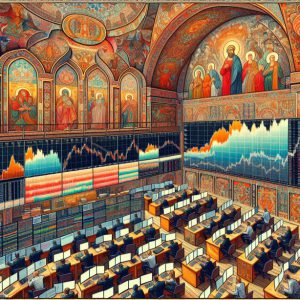
What is the Greater Fool Theory in Investing: Stay Calm, Avoid Foolish Reactions
July 3, 2024
The Greater Fool Theory is a fascinating concept in the investing world that has captivated the minds of traders, economists, and psychologists alike. At its core, this theory suggests that the price of an asset is not determined by its intrinsic value but rather by the collective expectations of market participants. In essence, it posits that investors can profit from overvalued assets as long as a “greater fool” is willing to pay an even higher price.
As we delve into this intriguing phenomenon, it’s crucial to understand its implications and learn how to navigate the treacherous waters it creates in financial markets. As our title suggests, the key is to stay calm and avoid foolish reactions. But how can we achieve this in the face of market irrationality?
The Psychology Behind the Theory
To truly grasp the Greater Fool Theory, we must first explore the psychological underpinnings that drive it. With all its quirks and irrationalities, human behaviour plays a central role in this market dynamic.
Daniel Kahneman, the renowned psychologist and Nobel laureate, offers valuable insights into this aspect. He posits that our brains operate on two systems: System 1, which is fast, intuitive, and emotional, and System 2, which is slower, more deliberative, and logical. In investing, the Greater Fool Theory often exploits our System 1 thinking, leading to quick, emotionally driven decisions that may not be in our best interest.
Kahneman explains, “The illusion that we understand the past fosters overconfidence in our ability to predict the future.” This overconfidence can lead investors to believe they can time the market perfectly, buying overvalued assets with the expectation of selling them to a “greater fool” before the bubble bursts.
The Role of Mass Psychology
Mass psychology plays a crucial role in perpetuating the Greater Fool Theory. As more investors buy into an overvalued asset, their collective behaviour creates a self-reinforcing cycle that drives prices even higher.
Gustave Le Bon, a pioneering sociologist from the late 19th century, observed this phenomenon in his seminal work “The Crowd: A Study of the Popular Mind.” He noted, “The masses have never thirsted after truth. They turn aside from evidence not to their taste, preferring to deify error if error seduces them.” In investing, this translates to market participants ignoring fundamental valuations in favour of following the crowd.
This herd mentality can lead to spectacular market bubbles, where asset prices become utterly detached from their underlying value. The dot-com bubble of the late 1990s serves as a prime example. During this period, investors poured money into internet-related companies, many of which had no clear path to profitability. The prevailing belief was that the “new economy” would render traditional valuation metrics obsolete.
As Alan Greenspan, former Chairman of the Federal Reserve, famously described it in 1996, there was “irrational exuberance” in the market. Yet, despite this early warning, the bubble continued to inflate for several more years before finally bursting in 2000, wiping out trillions of dollars in market value.
Technical Analysis: A Double-Edged Sword
Technical analysis, often viewed sceptically by proponents of fundamental analysis, can provide valuable insights when combined with an understanding of mass psychology. Rather than being a sophisticated form of the Greater Fool Theory, as some critics contend, technical analysis can help investors identify patterns that reflect the collective psychology of market participants.
John J. Murphy, a leading technical analyst, argues that “Charts don’t move markets; people move markets, and charts reflect the psychological mood of the marketplace.” Astute investors can gain insights into market sentiment and potential price movements by studying chart patterns and momentum indicators.
For instance, recognizing a head and shoulders pattern in a chart suggests a potential price reversal and a shift in market sentiment from bullish to bearish. This insight allows savvy investors to anticipate and potentially profit from the actions of the “greater fools” who may be late to recognize the changing trend.
Cognitive Biases: The Fuel for Greater Fools
Several cognitive biases perpetuate the Greater Fool Theory. Understanding these biases is crucial for investors who wish to avoid becoming the “greatest fool” in the market.
1. Confirmation Bias: Investors tend to seek information confirming their beliefs while ignoring contradictory evidence. This can lead to overconfidence in investment decisions and failure to recognize changing market conditions.
2. Anchoring Bias: People often rely too heavily on the first information they receive (the “anchor”) when making decisions. In investing, this can manifest as fixating on a stock’s previous high price or a specific valuation metric, even when circumstances have changed.
3. Recency Bias: Investors may give too much weight to recent events and extrapolate short-term trends into the future. This can lead to chasing performance in hot sectors or panic selling during temporary market downturns.
4. Loss Aversion: The tendency to feel the pain of losses more acutely than the pleasure of gains can cause investors to hold onto losing positions too long or avoid taking necessary risks.
Richard Thaler, another Nobel laureate in economics, has extensively studied these biases and their impact on financial decision-making. He notes, “The purely economic man is indeed close to being a social moron. Economic theory has traditionally assumed that the rational man has the cognitive ability of a supercomputer and the willpower of a saint.” Recognizing our cognitive limitations is the first step in overcoming them.
Historical Perspectives on Foolishness in Markets
The Greater Fool Theory is not a modern phenomenon. Throughout history, markets have experienced periods of irrational exuberance followed by painful crashes. By examining these historical episodes, we can gain valuable insights into the recurring patterns of human behaviour in financial markets.
Imhotep, the ancient Egyptian polymath who lived around 2650 BC, understood the importance of careful observation and measurement. While he couldn’t have foreseen modern financial markets, his understanding of natural phenomena could be applied to market analysis. As he observed the Nile’s flood patterns to predict agricultural yields, modern investors can observe market patterns to anticipate potential booms and busts.
Fast forward to the 17th century, and we find one of the earliest well-documented market bubbles: the Dutch Tulip Mania. At the peak of this speculative frenzy, a single tulip bulb could sell for more than ten times the annual income of a skilled craftsman. The philosopher Voltaire, reflecting on this episode a century later, quipped, “Men will cease to commit follies only when they cease to be men.” His observation underscores the recurring nature of market manias driven by the Greater Fool Theory.
In the 18th century, the Scottish philosopher David Hume provided insights that are still relevant to understanding market psychology today. He observed, “Reason is, and ought only to be the slave of the passions, and can never pretend to any other office than to serve and obey them.” This tension between reason and emotion lies at the heart of many investment decisions and can explain why markets often overshoot on both the upside and the downside.
Staying Calm: Strategies for Avoiding Foolish Reactions
Given the powerful psychological forces in financial markets, how can investors stay calm and avoid becoming the “greatest fool”? Here are some strategies:
1. Develop a Long-Term Perspective: Warren Buffett, one of the most successful investors of all time, advises, “If you aren’t willing to own a stock for ten years, don’t even think about owning it for 10 minutes.” This long-term approach can help investors avoid catching up in short-term market fluctuations driven by the Greater Fool Theory.
2. Practice Contrarian Thinking: Buffett famously said, “Be fearful when others are greedy, and greedy when others are fearful.” This contrarian approach can help investors avoid buying at market tops and selling at market bottoms.
3. Focus on Fundamental Value: Benjamin Graham, the father of value investing, emphasized the importance of focusing on the intrinsic value of assets rather than market sentiment. He stated, “In the short run, the market is a voting machine, but in the long run, it is a weighing machine.”
4. Diversify Your Portfolio: Modern Portfolio Theory, developed by Harry Markowitz in the 1950s, emphasizes the importance of diversification in reducing risk. By spreading investments across different asset classes and sectors, investors can mitigate the impact of any single “foolish” decision.
5. Educate Yourself Continuously: As the markets evolve, so should an investor’s knowledge. Ray Dalio, founder of Bridgewater Associates, stresses the importance of continuous learning: “The biggest mistake investors make is to believe that what happened in the recent past is likely to persist.”
6. Use Technical Analysis Wisely: While not infallible, technical analysis can provide valuable insights when combined with fundamental analysis and an understanding of market psychology. As John Murphy notes, “The technical analyst’s goal is to identify trends and trend changes at an early stage and maintain an investment posture until the weight of evidence indicates that the trend has reversed.”
Conclusion: Wisdom in the Face of Folly
The Greater Fool Theory powerfully reminds us of the irrational forces that can drive financial markets. By understanding these forces and developing strategies to counteract them, investors can navigate the complex world of investing with greater confidence and success.
As we reflect on the insights from thinkers spanning over four millennia – from Imhotep to Warren Buffett – we see that human nature and its impact on markets have remained remarkably consistent. The challenge for modern investors is to learn from this collective wisdom and apply it in an ever-changing financial landscape.
In the words of Leonardo da Vinci, “The greatest deception men suffer is from their own opinions.” By staying calm, avoiding foolish reactions, and maintaining a balanced, informed perspective, investors can hope to avoid becoming the “greatest fool” and instead position themselves for long-term success in the markets.
Remember, in the game of investing, it’s not about finding a greater fool to sell to – it’s about becoming a wiser investor yourself.
Escapes to Insight: Transcending Boundaries of the Mind

A Novel Idea: Shattering the Myth of the Gold Standard

What are logical positivism examples in investing?

Does Technical Analysis Work? Unveiling The Truth

What is the Gambler’s Fallacy? The Fast Track to Financial Ruin

What does recency bias mean?

As Misinformation Wars Intensify: Stay Alert, Don’t Get Blindsided

S&P 500 Stock Market Crash 2008 Chart: Focus on Opportunity

RSI Divergence: Outsmart the Masses and Triumph in the Markets

Stock Market Turbulence: How to Profit While Others Panic

What is Gambler’s Fallacy in Investing? Stupidity Meets Greed

Stock Market Crash 2008 Chart vs 2020: Don’t Repeat the Mistakes of the Past

What is flocking behaviour?

Collective Psychology: Winning Strategies Against the Masses That Ignore History

What is considered the opposite of recency bias?



